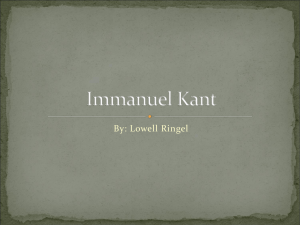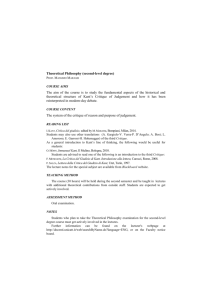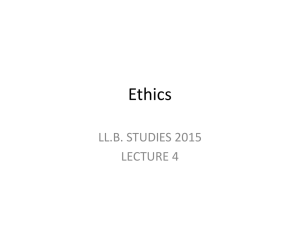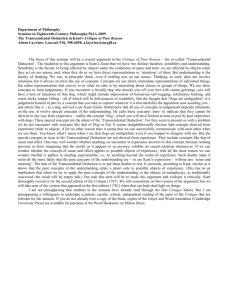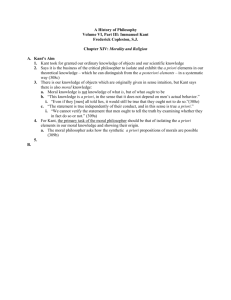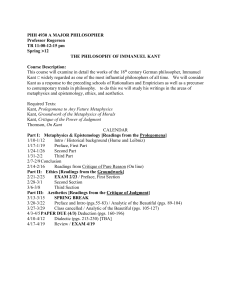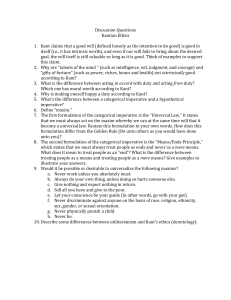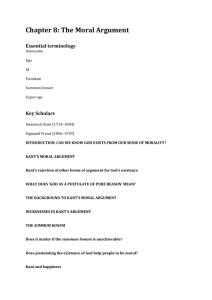9.4 An Overview of Kantian Epistemology: Class 11
advertisement
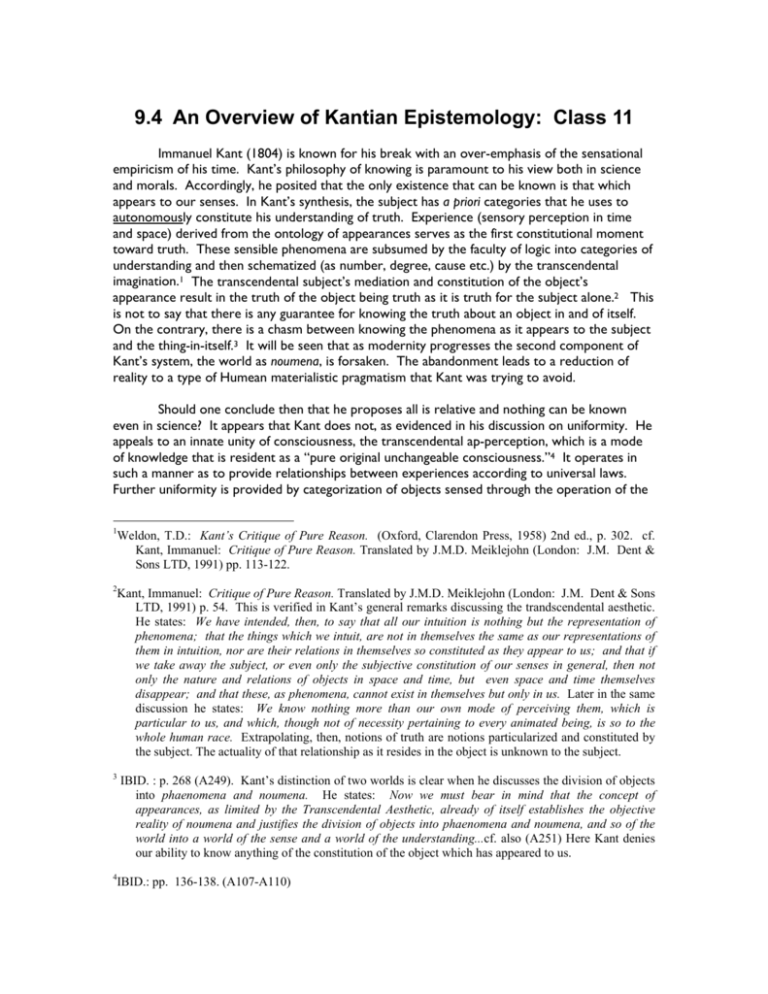
9.4 An Overview of Kantian Epistemology: Class 11 Immanuel Kant (1804) is known for his break with an over-emphasis of the sensational empiricism of his time. Kant’s philosophy of knowing is paramount to his view both in science and morals. Accordingly, he posited that the only existence that can be known is that which appears to our senses. In Kant’s synthesis, the subject has a priori categories that he uses to autonomously constitute his understanding of truth. Experience (sensory perception in time and space) derived from the ontology of appearances serves as the first constitutional moment toward truth. These sensible phenomena are subsumed by the faculty of logic into categories of understanding and then schematized (as number, degree, cause etc.) by the transcendental imagination.1 The transcendental subject’s mediation and constitution of the object’s appearance result in the truth of the object being truth as it is truth for the subject alone.2 This is not to say that there is any guarantee for knowing the truth about an object in and of itself. On the contrary, there is a chasm between knowing the phenomena as it appears to the subject and the thing-in-itself.3 It will be seen that as modernity progresses the second component of Kant’s system, the world as noumena, is forsaken. The abandonment leads to a reduction of reality to a type of Humean materialistic pragmatism that Kant was trying to avoid. Should one conclude then that he proposes all is relative and nothing can be known even in science? It appears that Kant does not, as evidenced in his discussion on uniformity. He appeals to an innate unity of consciousness, the transcendental ap-perception, which is a mode of knowledge that is resident as a “pure original unchangeable consciousness.”4 It operates in such a manner as to provide relationships between experiences according to universal laws. Further uniformity is provided by categorization of objects sensed through the operation of the 1 Weldon, T.D.: Kant’s Critique of Pure Reason. (Oxford, Clarendon Press, 1958) 2nd ed., p. 302. cf. Kant, Immanuel: Critique of Pure Reason. Translated by J.M.D. Meiklejohn (London: J.M. Dent & Sons LTD, 1991) pp. 113-122. 2 Kant, Immanuel: Critique of Pure Reason. Translated by J.M.D. Meiklejohn (London: J.M. Dent & Sons LTD, 1991) p. 54. This is verified in Kant’s general remarks discussing the trandscendental aesthetic. He states: We have intended, then, to say that all our intuition is nothing but the representation of phenomena; that the things which we intuit, are not in themselves the same as our representations of them in intuition, nor are their relations in themselves so constituted as they appear to us; and that if we take away the subject, or even only the subjective constitution of our senses in general, then not only the nature and relations of objects in space and time, but even space and time themselves disappear; and that these, as phenomena, cannot exist in themselves but only in us. Later in the same discussion he states: We know nothing more than our own mode of perceiving them, which is particular to us, and which, though not of necessity pertaining to every animated being, is so to the whole human race. Extrapolating, then, notions of truth are notions particularized and constituted by the subject. The actuality of that relationship as it resides in the object is unknown to the subject. 3 IBID. : p. 268 (A249). Kant’s distinction of two worlds is clear when he discusses the division of objects into phaenomena and noumena. He states: Now we must bear in mind that the concept of appearances, as limited by the Transcendental Aesthetic, already of itself establishes the objective reality of noumena and justifies the division of objects into phaenomena and noumena, and so of the world into a world of the sense and a world of the understanding...cf. also (A251) Here Kant denies our ability to know anything of the constitution of the object which has appeared to us. 4 IBID.: pp. 136-138. (A107-A110) subject’s transcendental logic. The a priori categories are universal as well. Intellectual constitution of sensed appearances by means of categorization and schematization provide the possibility of empirical science. Here Kant clearly differs from Hume and his notion that causeeffect is a matter of ‘custom and habit’ alone. Laws like those of science are not derived from the categories but from experience. Experience, however, conforms to the categories thus linking a priori categories to the operation of empirical investigation.5 Kant exemplifies a phenomenal epistemology called transcendental idealism highlighted by the chasm between the realities of the phenomenal and their conformation to the categories of our mind. That noumena could be made matters of knowledge in the sense that matters of sense result in knowledge was rejected by Kant. He has been interpreted as positing that matters of metaphysics were “to be held to as matters of what he called pure rational faith.”6 For Kant the method of inquiry into metaphysics must be the same as that of Newtonian science, analysis. What differed was that the subject matter was neither sensible objective nor revealed beyond or above that of our senses. His famous statement gives us a sense of the limits of empirical reasoning when approaching the borders of metaphysical considerations: “I have found it necessary to deny knowledge, in order to make room for faith.”7 His approach was exemplified in his attacks on the ontological, cosmological, and design arguments for the existence of God. He does not resign the proof of God unattainable however. Kant argues for the existence of God from the staring point of the immediate experience of our moral context. As the subject attempts to obtain happiness while living a life of good virtue, he affirms the existence of God. It is an affirmation based on conviction expressed through practice. In Kant’s construction, God is not a logical certainty but rather an existential moral necessity. He states: No, my conviction is not logical, but moral certainty; and since it rests on subjective grounds (of moral sentiment), I must not even say, It is morally certain that there is a God, etc.’, but ‘I am morally certain, etc.’ In other words, belief in a God and in another world is so interwoven with my moral sentiment that there is little danger of my losing the latter, there is equally little cause for fear of the former can ever be taken from me.8 Although Kant is self-assured that he will never capitulate to those denying God’s existence, his moral sentiment argument provides little more than canon fauder for the arguments of nihilists like Nietzsche.9 More important than the credibility of Kant’s argument, however; is his application of analytical method in an attempt to uncover a universal overriding moral principle, 5 Kant, Immanuel: Critique of Pure Reason, translated by Norman Kemp Smith (New York: St. Martin’s Press, 1965) p. 173 (B165) Kant’s estimation of the starting point of mathematics as arbitrary, causes one to pause and reconsider the presuppositions of those claiming the superiority of positive sciences over the more speculative. The primary quantifying tool of these positivists, mathematics, may not be so free from speculation as they might have us believe. 6 Walsh, W.H.: “Immanuel Kant,” Encyclopedia of Philosophy, edited by Paul Edwards. (New York: Macmillan Publishing Co., reprint 1972) v. 4, p. 309. 7 Kant, Immanuel: Critique of Pure Reason, translated by Norman Kemp Smith (New York: St. Martin’s Press, 1965) p. 29. 8 IBID: p. 650. (B857) 9 cf. Friederich Nietzsche’s The Irrationality of Religious Sentiment. the categorical imperative. As part of his inquiry he posits the sole principle of all moral laws, autonomy.10 A perversion of his principle, where heteronomy of choice is mistaken for autonomy, will become a dominate voice in the ‘rights’ rhetoric of medical ethics. In summary, when considering the further split of Kant’s phenomenal and neumonal worlds, it is difficult to locate him on our chart. Because he recognizes the existence of God and a discernable metaphysics, he cannot be classified as a metaphysical agnostic. On the other hand, he clearly is skeptical in regard to what and how we can know reality. He appeals to an apparent innate emergence of ideas, yet one far from knowable by transcendental logic and sensation. At this time he will be located with the phenomenalists . For any of these, if objective reality to be significant to the subject, it must pass through the bottleneck of subjectivity. It is the issue of meaning that is at stake. SENSE DATA SUBJECT SELF KNOWER OBJECT WORLD THING KNOWN EXPERIENCE APPEARANCE (Issue: How are they related) cf. Hunnex, Milton The emphasis is on the mental state yet with the awareness that there must be sensation to ‘emerge’ mentation. “Concepts without percepts are empty, percepts without concepts are blind.” cf Hunnex p. 11. 10 Kant, Immanuel: Critique of Practical Reasoning, translated by Lewis White Beck (New York, Macmillian Publishing, 3rd edition, 1993)p. 33. Positing Theorem IV Kant states: The autonomy of the will is the sole principle of all moral laws and of the duties conforming to them; heteronomy of choice, on the other hand, not only does not establish any obligation but is opposed to the principle of obligation and to the morality of the will. A. B. C. D. E. Internalist Theories Doxastic Theories Subjectivism F. G. H. I. J. Externalist Theories Non-Doxastic Theories Objectivism A. Radical Skepticism, Cratylis B. Pure Phenomenalism, Hume C. Phenomenalism, Kant, Comte, Mill, Ayer D. Pragmaticism, James (British Empiricism-Behaviorism), Pierce (Social) E. Representative Realism, Descartes and Locke F. Neo-Thomism, Maritain, Gilson, Copelston (Jesuits) G. Personalism, Bergson, Husserl, Levinas, Hieronymus Minoris H. Objective idealism, Hegel I. Common Sense Realism (Moore) J. Radical Materialism (Montague) Readings for Class Twelve: Hamlyn, D.W.: Encyclopedia of Philosophy v.3 “Epistemology, History of (Post-Kantian Idealist Philosophy) ”, pp. 30d-37c; MacKenzie, Charles F: “Kant’s Copernican Revolution,” in Building a Christian World View, edited by W. Andrew Hoffecker and Gary Scott Smith (Phillipsbury, New Jersey: Puritan Reformed, 1986) v. 1, pp. 297-317; Copleston, Frederick: “Introduction,” in A History of Philosophy. (NY: Double Day Publishing, April, 1985) Book Three, part four, “Hegel,” Book Three,v. 7,” pp. 159-166, 189-205. Hegel, G.W.F.: Philosophy of the Right. And Philosophy of History in (Great Books of the Western World Series) published by William Bennett (Chicago: Encyclopedia Britannica, 1952) v. 46 pp. 6-7 (the famous ‘owl of Minerva’ passage); pp. 9-20; p. 21 note the will; pp. 50-56; pp. 77-78; p. 115; pp. 156 (III)-p. 160; p. 185-186 note spirit’s development ;p. 278 Para 2; p. 354 Hegel, G.W.F.: Faith and Knowledge, translated and edited by Walter Cerf & H.S. Harris (SUNY, NY: 1977) pp. xi-xxxv, 55-66, 189-191. One Page Written Assignment: Same as last week. Begin your final drawing and 20 page paper.
